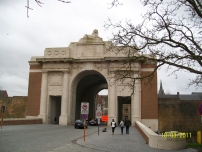| First Name: | James | Last Name: | NEWMAN | |
|---|---|---|---|---|
| Date of Death: | 11/11/1914 | Lived/Born In: | Edmonton | |
| Rank: | Lance Corporal | Unit: | Royal Fusiliers4 | |
| Memorial Site: | 1. Wood Green Memorial 2. Menin Gate, Ypres | |||
Current Information:Age-28 111, Angel Road, Edmonton
First Battle of Ypres Between 21st October and 22nd November, 1914 a desperate fight took place around the Belgium city of Ypres, the first of three major battles that were to be fought there during the course of the war. British troops entered Ypres in October. The 1st and 2nd Divisions plus the 3rd Cavalry Division had made their way up from the Aisne as part of the “Race to the Sea”, whilst the 7th Division came west to Ypres after Antwerp had fallen. The Germans knew that Ypres was the gateway to the Channel ports and that these were vital to Britain’s war effort so they poured reinforcements into the area. The fighting fell into three distinct battles; the Battle of Langemarck, 21-24 October, the Battle of Gheluvelt, 29-31 October and the Battle of Nonne Bosschen, 11 November. Ypres did not fall to the Germans but its defence during these two months resulted in the destruction of much of the old regular British Army. The Battle of Nonne Bosschen The battle of Nonne Bosschen on 11th November, 1914 was the final German attempt to break through the British lines around Ypres. They threw twelve and a half divisions into an attack against a nine mile front, stretching from Messines to Reutel (close to Polygon Wood). The main thrust of their attack was either side of the Menin Road where two fresh divisions, numbering around 10,000 men were thrown against eleven tired and depleted British divisions of around 4000 men. The attack was launched at 9 am after the heaviest artillery barrage yet seen and was protected by early morning mist. Astride the Menin Road the defenders were forced to give ground but more critical was the attack that penetrated the Guards Brigade line just to the north and allowed the Germans to get into Nonne Bosschen woods and threaten the artillery line. This threat was averted in the afternoon when a counter attack cleared the Germans from the wood. There was now no chance of a breakthrough and although the Germans made a few minor attacks over the next few days the First Battle of Ypres was finished. On 6th November, 1914, the 4th Royal Fusiliers battalion of 9 Brigade, 3rd Division, moved north to the Ypres salient and took over positions from 6 Cavalry Brigade, east of Hooge on the south side of the Ypres-Menin road on the edge of Herenthage Wood. On 11th November at 6.30 am on a dull and misty morning the German shelling of the British line began and proved to be the severest yet. 2 ½ hours later the German infantry attacked. 4th Royal Fusiliers were confronted by 4th(Queen Augusta’s) Guard Grenadiers whose 1st assault was thrown back. But by now 4th Royal Fusiliers had only one officer left and he was wounded and when the Germans launched their second attack they drove the dwindling numbers of the battalion back on to their supports, most of whom were a recently arrived draft. At 4 pm there was an attempt to regain these lost trenches by a frontal attack of 4th Royal Fusiliers and 1st Royal Scots Fusiliers and a flank attack by 1st Northumberland Fusiliers but this failed and there were many casualties from the close fighting in Herenthage Wood. By the end of the day there were only 100 left of 4th Royal Fusiliers, but the Germans gained nothing other than a short section of trench and themselves suffered severe casualties. James Newman was one of those who did not survive the day. |
||||
| « Back to Search Results | ||||
| If you think any of the information shown here is incorrect, Click Here to submit your amends and comments | ||||




